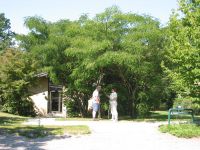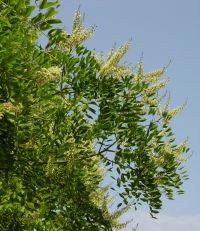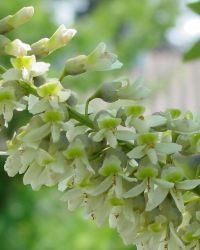No english name - Maackia fauriei
Scientific name:
Maackia fauriei
Family:
Fabaceae (Pea family)
Height:
to 6 M in Hørsholm
Flowering:
Late July to early August
Range:
Korea, Jeju Island
 |
|
 |
 |
The Maackia fauriei plants in the pictures are from seed collected by the Nordic Arboretum Committee expedition to Korea in 1976. The seed was collected on the volcano, Mt. Halla on the island Cheju-do (or Jeju-do). They can be found in square 1016 positions 2637 to 2640 on the grass plain on the east side of the newer office buildings near the front gate. A map with squares and positions can be found on our homepage under: Plant search.
Plant description:
The genus Maackia is composed of 8 to 10 species all of which come from East Asia. Two of which are found in our collection. This genus is closely related to the genus Cladrastis and was once placed in there, but it differs in several important morphological characters and in its DNA.
The genus is named after the Russian naturalist Richard Maack who died in 1886. We have 8 examples of Maqackia fauriei in the Arboretum.
Three are from seed collected in the wild on Mt. Halla during the Nordic Arboretum Committees expedition to Korea in 1976.
The rest are from seed collected from this original material. Second generation seedlings have been sent to a number of other places including: Norwegian National Arboretum, Swedens Agricultural University, Alnarp, Arboretum Trompenborg in Holland; Århus Kommune (probably the Botanic Garden, Århus).
Maackia fauriei was made know to western science by Abbé Faurie in 1907, and was first introduced into European cultivation in 1917 by E. H. Wlson. It is not mentioned in Lange book: Kulturlanternes indførselshistorie i Danmark and the introduction from the expedition in 1976 is possibly the first introduction to Denmark.
Maackia fauriei (Solbi tree in Korean) is a modern medicine plant and the bark is used to produce a Lectin, MFA (Maackia Fauriei Agglutinin). This compound, patented in 2006, is used in medicinal research, cancer diagnosis, and as an anticancer agent. This agent is considerably cheaper to make than other similar chemicals. These are large deciduous shrubs or small trees reaching about 5 m in Hørsholm.
They have pinnate leaves with 8 to 16 opposite leaflets and one terminal leaflet. The new leaves are silvery-grey when expanding which adds to the horticultural value. The colour is lost by July. Leaflets are ovate, 3-6 cm long and with a rounded or broadly wedge-shaped at the base. They are dark green on the upper surface and lighter green below. The flowers are white with a green blotch on the upper, (standard) petal and produced on a dense panicle. Pods are about 5 cm long.
M. fauriei is a handsome smaller flowering tree or large shrub. It was recommended in the Arboretums Guide published in 1994 as a potential garden plant and Maackia fauriei Hörsholm is being sold in nurseries in Sweden and is probably progeny from the three older plants in our collection. We have observed bark necrosis on some stems on one plant which may be a result of frost damage. Nevertheless, our specimens are attractive most of the time and one can still recommend this plant as an unusual addition to the home garden or park Maackia fauriei is easy to propagate from seed following an acid treatment, but mature seed is only produced on these plants after warm summers, with early flowering.
References:
Bean, W.J. 1980 Trees and Shrubs Hardy in the British Isles Vol II. D-M Eight edition. John Murray publishers. 784 pp.
Jensen, N. 1994. Guide til Arboretet i Hørsholm (Guide to the Arboretum in Hørsholm). Dansk Dendrologisk Årsskrift. 12:1-237.
Lange, J. 1999. Kulturplanternes Indførselshistorie i Danmark indtil midten af 1900-talet. (Introduction History of Cultivated Plants in Denmark up to the middle of the 20th century). DSR Forlag, Frederiksberg C. 458 pp.
Mabberley, D.J. 1998. The Plant Book. The Bath Press, Bath, 858 pp.
Olsen, O. et al. 1997 Havens Planteleksikon. Træer og Buske. (Danish Plant Encyclopedia, Trees & Bushes). Det Danske Haveselskab Publisher, 674 pp.
